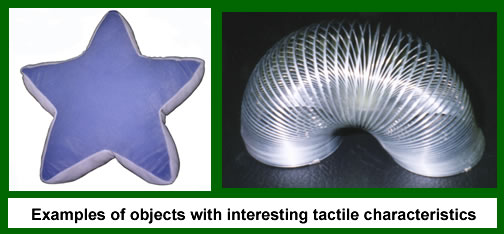Project SALUTE: Successful Adaptations for Learning to Use Touch Effectively

Project SALUTE: Successful Adaptations for Learning to Use Touch Effectively, under the leadership of Dr. Deborah Chen, was a model demonstration project funded by the U.S. Department of Education to California State University, Northridge from September 1, 1999 to August 30, 2004 to serve as a "resource on tactile learning strategies for working with children who are deaf-blind or blind with additional disabilities". It had three purposes:
-
to provide procedures for service providers to document tactile strategies being used with individual students
-
to assist families and service providers in sharing challenges and successes in using tactile strategies, and
-
to disseminate the findings of Project SALUTE and information on tactile strategies.
The project promoted literacy experiences for children who are deaf-blind and do not have symbolic language skills to encourage them to participate in emergent literacy activities. Lessons learned from the project include examples, considerations, advantages, and disadvantages of the project.
Guidelines for Promoting Emergent Literacy with Children Who Are Deafblind
- Provide language-rich activities, materials, and environments to support a child’s experiences with literacy. These include playing together, describing objects, discussing events, supporting the child’s access to language, conversations, stories, and books.
-
As appropriate, use varied intonation, gestures, signs, objects and tactile items to engage the child in a conversation or story.
-
Build on real experiences that children enjoy as a beginning point for literacy experiences by referring to tactile items associated with these experiences. These tactile items should be organized in a "story or memory" box or book so that the child can refer to events and "reread" these stories.
-
Expose the child to braille in a similar manner that young sighted children are exposed to print, e.g., on labels. The child should feel the braille even though the child may not be able to read this abstract symbol system. Through repeated and consistent exposures, the child will assign meaning to the braille dots.
-
Read familiar, interesting, and relevant books repeatedly with the child.
-
Ask the child to "read" a favorite book to you by touching tactile items in sequence and using gestures or other means of communication.
-
Provide opportunities for interaction. Pause during the story and wait for the child to feel tactile items, the braille, and to comment or anticipate what happens next. Allow the child to hold the book, turn the pages, and manipulate tactile features. If needed, add tabs to the pages to make them easier for the child to turn.
-
Have the child participate in the development of tactile books and displays using items that represent favorite activities or experiences.
-
Whenever possible, help the child make connections between these experience stories and current or upcoming events.
-
Include individualized tactile books in a child’s portfolio that will follow the child from grade to grade.
-
As the child gains greater understanding of different literacy experiences, more and more abstract methods of representation can be used.
-
The use of jumbo braille cells for reading may be helpful for some children.

Information Sheets on Emergent Literacy for Children Who Are Deafblind
The project included the creation of the following information sheets (Spanish versions are in parentheses)
- Coactive Signing (Haciendo Señas Coactivas)
- Communication Symbols (Símbolos para la Comunicación)
- Emergent Literacy for Children Who Are Deaf-Blind (Alfabetización Emergente para Niños con Sordoceguera)
- Mutual Tactile Attention (Atención Táctil Mutua)
- Object Cue (Clave-Objeto)
- Selected Definitions (Definiciones Seleccionadas)
- Sign on Body (Seña Sobre el Cuerpo)
- Tactile Communication Strategies (Estrategias Táctiles de Comunicación)
- Tactile Modeling (Modelaje Táctil)
- Tactile Signing (Haciendo Señas Táctiles)
- Tangible Symbols (Símbolos Tangibles)
- Textured Symbols (Símbolos de Texturas)
- Touch Cue (Clave-Toque)
Professional Perspectives
- Occupational Therapy For Young Children With Visual Impairments and Additional Disabilities by Jill Brody, M.A., O.T.R.
-
Tactile Strategies for Young Children who are Deaf-Blind: A Teacher’s Perspective by Patty Salcedo, M.A.
